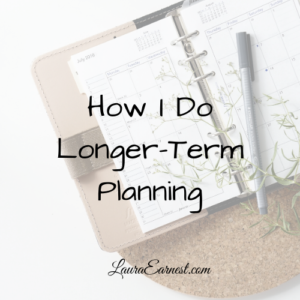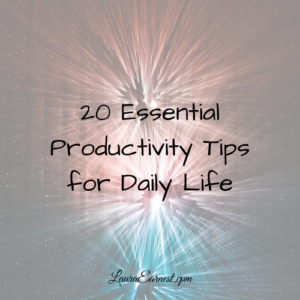How I Do Longer-Term Planning
Daily and weekly planning will get you through the day-to-day without having tasks pile up for a massive weekend task-fest. But isn't there more to life than just the day-to-day? For a long time I existed on daily and weekly planning only. Partially it was because I was just so busy juggling all of my commitments (work, child, house, spouse and volunteer) that I didn't have room for anything more. I would plow through my days, insanely productive, falling into bed at night exhausted. But there was never anything more. The novel I wanted to write remained a remote dream, and my craft closet morphed into a craft room with supplies for unstarted projects. Partially it was because I was completely flummoxed by the thought of thinking of a 5- or 10-year plan. I couldn't even see the end of the week for the enormous pile of…
How I Do Daily Planning
Doing a weekly plan (see How I Do Weekly Planning) is a great way to frame your tasks in your schedule. But it isn't enough, because you need to be able to figure out what you will do on any given day. Today we will look at how I do my daily planning, based on my weekly plan. As I have shared before, I learned how to do daily planning when I purchased my first planner. It was a two page per day spread, with a time grid on one side, and a list for tasks on the other. Every day, I would fill in my schedule, then list the tasks I wanted to get done that day. If I didn't get them done, I rewrote them onto the next day, adding new tasks. Regardless of what my schedule looked like. Since I was a full-time engineering…
How I Do Weekly Planning
I do three different types of planning in order to keep myself on track and productive: daily, weekly and long-term. This month we will be looking at all three. We'll start with what I consider the most important for my productivity: the weekly plan. When I first purchased my first planner, I didn't know anything about planning. And the system didn't educate me either. I had a 2 page per day Daytimer, and the instructions were just about how to plan a day. I was in college at the time, and I could never figure out how I always had so much left to do at the end of each day! The problem for me, as most people I have talked to, is that the schedule is not constant. Some days are busier than others. And yet we never step back and take that into account. Getting…
Podcast Episode 20: Getting Back Motivation
Most of us now have time to tackle all those things we wanted to "when we have time." So why aren't we? We'll look at the causes and the cures today.
Evernote: Managing Someday Tasks
Most people have moments when they see something and think, "I'd like to do that someday." If you're not going to forget about it, that means you either have to do it right now or write it down somewhere so you won't forget. David Allen, in Getting Things Done, recommended having a Someday/Maybe list, where all of these ideas reside. The problem with any sort of list is that if you keep stuffing things into it, without removing items in turn, it becomes a giant slush pile of un-acted-upon ideas. As an IT data professional, I can tell you that a system where you only put things in, without the ability or inclination to take it out again, is a failure. If you can't or won't get data out of a system, why put it in at all? It's wasted effort/time/money. So the ginormous list of things…
Getting The Most Out of Batching
The two-minute rule says that if you can deal with it in under 2 minutes, do it right then. In some cases, I think this is a good rule. But in others, I think batching is a better way to go. Batching is grouping like tasks together and getting them done. They don't all have to be the same task - you can batch by location or equipment. For instance, you could update your calendar, pay for your pet licenses, and process your email in a batch, because you can do all these things on your computer.
20 Essential Productivity Tips For Daily Life
Productivity is not simply just about how you do your work. Peak productivity takes into account your physical state, distraction level, energy, and organization. Today we will look at 20 essential productivity tips for your daily life. I used to be a person who would make a list and just plow through it, regardless of how I felt, what was going on, or any other consideration. I hated the phrase "work smarter, not harder" because it seemed a wimpy way out. But there is a lot to be gained from working smarter, and that means I have to take into account all of the areas of my life in order to hit peak productivity with minimal effort. Here are the 20 areas that go into my strategy for getting the most done with the least amount of effort.
Change Your Life With the Bullet Journal Method
If you have ever gotten frustrated with a pre-made planner because you ended up working to fit the planner, rather than the planner fitting you, there is a solution. That solution is Bullet Journaling.






